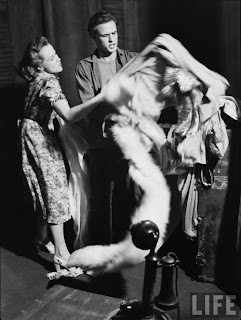Tennessee Williams wrote his Pulitzer Prize winning play "A Streetcar Named Desire" in 1947. The play centers around the lives of four people: Blanche Du Bois (originally acted on stage by Jessica Tandy), Stanley Kowalski (originally acted on stage by a relatively unknown Marlon Brando), Stella Kowalski (originally acted on stage by Kim Hunter) and Mitch (originally acted on stage by Karl Madden). The play is set in the seedy strip of the French Quarter in New Orleans. The claustrophobic heat in the air of New Orleans lends itself perfectly to characters on the verge of boiling over and losing everything. Williams play opened to a shocked but fascinated audience. The plays themes of alienation, disorientation, redemption, loss, emotional and physical abuse, and mental illness pushed the boundaries of mainstream theater written during the 1940s. "A Streetcar Named Desire" was immediately hailed by critics as a boundary breaking masterpiece; a play for which Williams won the 1948 Pulitzer Prize for Drama. Just a few short years later, Williams approached Elia Kazan (who had directed the first US Theater production of Streetcar on Broadway) to adapt his play for the screen. Kazan initially objected to turning the already beloved play into a film but eventually, with the support of Williams, they adapted the story together. The film would go on to cast nine of the original cast members playing the same roles they performed on stage, including Brando, Hunter, Malden. The only change was the part of Blanche. Vivien Leigh was offered the part over Jessica Tandy, due to Leigh's rising star power. Ironically, Vivien later suffered from bi-polar disorder, much like Blanche in the film, and her mental instability would only enhance her performance of the fading and disturbed southern belle.
Because of the enforcement of the Hays Code, the film had to change two major plot points for film audiences. Blanche, citing the reason for her late husband's suicide as a general weakness, helped to imply that he was a homosexual, which at the time the film was made was not directly implicated onscreen. This narrative point helps to further understand Blanche and her compulsive need for male attention to survive. Clearly her husband's sexuality and eventual self inflicted death would've directly influenced her feeling of inadequacy and sexual impotence. This is one of the main reasons Blanche suffers a break from reality and begins to deteriorate mentally. The film deals with this "loss of content" rather eloquently, and even though the sexuality of her late husband is never directly referred to in the film, the viewer understands Blanche's feelings of loss and its impact on her mental faculties.
The second stipulation of the code was the change in the ending of the film. In the play, Stanley rapes Blanche and severs her last fragile tie to reality, plummeting her into the darkness of insanity. Even though the rape occurs in the film (although it occurs offscreen), the ending in the play and the film dramatically differ. Stanley is a brute, a man fueled by his desire. His relationship with his wife Stella is built on a sexual hunger and rests in the comfort of her willingness to stay with him, despite the violence. The play ends with the violent rape of Stella's sister. Stanley races to find Stella and the play ends with them wrapped in a embrace; Stanley on his knees grasping for Stella's breast. Stella stays. The ending of the film ends on a completely different note and tone. The code was implicit in it's insistence on punishing the rapist. So the end of the film ends with rape and Stanley frantically searching for Stella, only she (grasping onto her newborn child) runs away from his embrace and the film ends with Stanley's cries echoing through the quarter.
Kazan was insistant on using space to create a visual representation of Blanche's mental deterioration. His art director, Richard Day, along with the set designer, George Tompkins, create a space they reduced in size as the film progressed. The Kowalski apartment becomes smaller and contained the more that Blanche becomes consumed by the claustrophobic space inside her head. The space surrounding her is visually contracted to exhibit her mental state. This is a feat of production design and helps the viewer feel a sense of the agony that Blanche is struggling to breathe through. The film is masterfully shot in black and white, and captures through shadow and space, the violence that is constantly at bay lurking in the depth of each of these characters. Blanche, towards the final climax of the film, pronounces to her potential lover, "I don't want realism, I want magic. Yes, yes magic. I try to give that to people. I do misrepresent things. I don't tell truths. I tell what ought to be true". This provides the moral of this story, Blanche would rather live her life in the shadows of her fantasies, because only within her mind, is she desired, beloved and held above all others. Reality only offers crushing disappointment and pain. She retreats into the recesses of her mind and creates a world without pain, and when given the choice, she would stay there forever.
Opening Tiles
Stanley at the table, lost inside his own head.
The undefinable Marlon Brando as Stanley
After one of Stanley's violent moments, clinging to Stella, the woman he loves.
Stanley exhibiting his anger and Blanche her poise
The real Streetcar named Desire in New Orleans
Stella begins to realize her sister is not herself
The unforgettable Vivien Leigh as Blanche
Stanley, going through Blanche's things, he is intent on hating her.
.jpeg)
_NRFPT_02.jpeg)


















